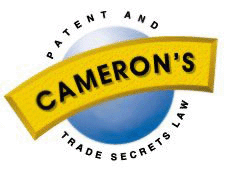
Case Comment
Consolboard Inc. v.
MacMillan Bloedel (Sask) Ltd.
citation(s): (1981) 56 C.P.R. (2d) 145 (S.C.C. per Dickson J.)
 Case Comment |
Consolboard Inc. v.
|
copyright 1997 Donald M. Cameron, Aird & Berlis
"Section 36 of the Patent Act lies at the heart of the whole patent system. The description of the invention therein provided for is the quid pro quo for which the inventor is given a monopoly for a limited term of years on the invention. As Fox points out in Canadian Law and Practice Relating to Letters Patent for Inventions, 4th ed. (1969l p. 163, the grant of a patent is in the nature of a bargain between the inventor on the one hand and the Crown, representing the public, on the other hand. The consideration for the grant is twofold:
... first, there must be a new and useful invention, and secondly, the inventor must, in return for the grant of a patent, give to the public an adequate description of the invention with sufficiently complete and accurate details as will enable a workman, skilled in the art to which the invention relates, to construct or use that invention when the period of the monopoly has expired".
The "description" to which Fox refers is that required by s. 36 of the Patent Act.
It cannot be said that s. 36 of the Act is happily phrased. It gives the impression of a mélange of ideas gathered at random rather than an attempt to enunciate, clearly and concisely, a governing principle or principles. This is perhaps understandable in that the section is the product of amendment over a period of many years. The language simply does not lend itself to a tight, literal interpretation. It is, and should be treated as, a parliamentary pronouncement, in general terms, of that which must be set forth by the applicant to the world before: being qualified to receive the grant of monopoly under a patent."
"In essence, what is called for in the specification (which includes both the "disclosure", i.e., the descriptive portion of the patent application, and the "claims") is a description of the invention and the method of producing or constructing it, coupled with a claim or claims which state those novel features in which the applicant wants an exclusive right. The specifications must define the precise and exact extent of the exclusive property and privilege claimed."
"Section 36(l) seeks an answer to the questions: "What is your invention?: How does it work?" With respect to each question the description must be correct and full in order that, as Thorson P. said in Minerals Separation North American Corp. v. Noranda Mines, Ltd. (1947), 12 C.P.R. at p. 102 at p. 111, [1947] Ex. C.R. 306 at p. 316, 6 Fox Pat. C. 130:"
"... when the period of the monopoly has expired the public will be able, having only the specification, to make the same successful use of the invention as the inventor could at the time of his application."
"We must look to the whole of the disclosure and the claims to ascertain the nature of the invention and methods of its performance (Noranda Mines Ltd. v. Minerals Separation North American Corp., 12 C.P.R. 99, [1950] S.C.R. 36, 9 Fox Pat. C. 165 [affirmed 15 C.P.R. 133, 12 Fox Pat. C. 123]), being neither benevolent nor harsh, but rather seeking a construction which is reasonable and fair to both patentee and public."
"I do not read the concluding words of [s.34(1)] as obliging the inventor in his disclosure or claims to describe in what respect the invention is new or in what way it is useful. He must say what it is he claims to have invented. He is not obliged to extol the effect or advantage of his discovery, if he describes his invention so as to produce it."
"The respondent contends that the proper test of an anticipation" is that the claim in suit "cover" or "read on" what the prior document would have taught as of the date of the invention to one skilled in the art: "what infringes if later, anticipates if earlier"; as Rinfret J. delivering the judgment of the Court in Lightning Fastener Co. Ltd. v. Colonial Fastener Co. Ltd. et al, [1933] 3 D.L.R. 348 at p. 352, [1933] S.C.R. 377 at p. 381, said: "But what amounts to infringement, if posterior, should, as a general rule, amount to anticipation, if anterior." In my view the claims in suit do more than merely read on the disclosure of the prior documents. Such disclosure does not contain clear instructions to do or make something that would infringe the patents in suit if carried out after the grant."
At p. 526 ** put in SCC page number
"Although (i) s. 36(1) requires the inventor to indicate and distinctly claim the part, improvement or combination which he claims as his invention and (ii) to be patentable an invention must be something new and useful (s. 2), and not known or used by any other person before the applicant invented it (s. 28(1)(a)), I do not read the concluding words of s. 36(1) as obliging the inventor in his disclosure or claims to describe in what respect the invention is new or in what ways it is useful. He must say what it is he claims to have invented. He is not obliged to extol the effect or advantage of his discovery, if he describes his invention so as to produce it."
Return to:
Cameron's IT Law: Home Page; Index
Cameron's Canadian Patent & Trade Secrets Law: Home Page; Index